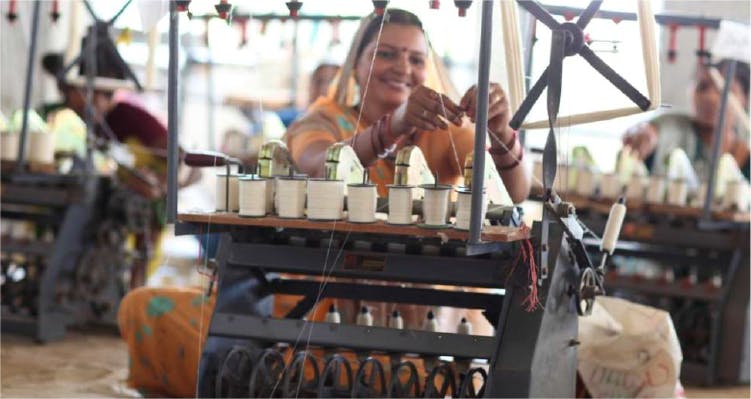By Rashi Wadhera
In between all the gota patti, jersey half-saris, embellished gowns and subtle sheers, we tend to forget the splendour, understated opulence and perennial nature of the quintessential Indian handloom. Call it revivalist, or in honour of the country's replete textile industry, but LBB shortlisted the top ten destinations for textiles and homegrown handlooms in the country, and companies that'll take you on the tour. For all the fabric, fashion and handloom loyalists, we've given you yet another reason to plan a quick getaway. And hey, you'll get to see some more of our fine country.
West BengalIndia is the second largest producer of Tussar silk, and the exclusive producer of Indian Tussar. Majority of this silk is produced in Malda, West Bengal and also Bhagalpur in Bihar. The good news about this textile is, owing to its lightweight and almost linen like feel, it drapes perfectly and can be used for a host of products including soft furnishings, handicrafts and fashion.
GujaratWeave this into your travel plans, for a first hand experience with the Tanchoi weave. A testament to the cultural exchange between China and India. And, bookmark Kutch, since it's one of the most prolific regions for textile art, including mirror work and hand embroidery {the Janpath variety}. Better still, Jaypore and Breakaway are hosting a 6 night 7 day textile trail in Ahmedabad and Kutch, exploring local textiles, artisans, and the technique of block printing. Find out more, here.
Banaras, Uttar PradeshOriginally produced by the Nawabs of Oudh, Jamdani weaves are still practiced in two main centers in Uttar Pradesh, Banaras being one of them. If the word seems familiar, but you aren't entirely sure what we're talking about, Jamdanis are thin textured muslin, with floral, animal and bird motifs woven into the loom. In Banaras, the craftspeople use gold thread, in addition to bleached and unbleached white thread, and still follow the traditional Jamdani pit looms to form designs. As for everything else Banaras is famous for, try your luck with Banarasi Silks and Brocades, since it is one of the most rich weaving craft centers of India.
Aurangabad, MaharashtraZari thread sown into fine silk fabrics, characterised by pallus decorated with peacocks and borders of an oblique square design, all hand woven, comprise the Paithani sari or weave. Almost tapestry reminiscent, if you've been part of a wedding household {especially from the girls side}, you'll know it's considered one of the richest weaves from Maharashtra. And hey, if you managed to finish a fabric selection on your first day, the Ajanta Caves are a stone's throw, so two birds one stone. All we're saying.
Tamil NaduTamil Nadu is actually a textile gold mine, and will cater to a variety of audiences. From leather, to knit wear, silks and cotton, Tamil Nadu is a must-do. It's most famous for its cotton and silk, with Kanchipuran and Arani ruling the roost, thanks to their pure Zari silk saris, and handloom silk weaving industries. Lucky for you, someone will take you on this trip. Jaypore with Breakaway, will take you on a curated journey to experience Tamil Nadu's textile tradition. Click here for more details.
Madhya PradeshMaheshwar, a city in Khargone district of MP, and home to one of India's finest handloom fabric traditions, is most popular for {you probably already got this}, the Maheshwari Sari and fabric. Essentially cotton, they're woven with distinctive designs including stripes, checks and floral borders. Jaypore in association with Breakaway, hosts curated tours exploring the rich textile history of Maheshwari and Bagh, where you get the chance to explore obscure villages, and meet skilled artisans along the way. Another gem MP produces: the much adored Chanderi. For a Central India tour, Jaypore has your back, find out more, here.
Andhra PradeshThis tops our list of destinations, given what we're about to tell you they produce. Put your hands together for the house of Ikat {well, after Indonesia}. Renowned for its handlooms, Andhra Pradesh produces some of the most exclusive saris and fabrics, all harbouring a design distinctive of the region. Originating from the Nalgonda districts, Ikat weaving is now practiced in the villages of Puttapaka, Pochampalli and Chautuppal. That said, if you don't want to get your hands dirty, the more commercial options are available across all major cities.
JaipurAs next door neighbours, we're no strangers to Jaipur's ability to be a reservoir for all things textile, be it bandhani, block printing, gota patti, zari and kinari work, with some magnificent jewellery to match. Since there's so much to choose from, Jaipur might get intimidating, especially given the slew of new, young designers competing with an age-old industry. Jaypore is hosting a textile trail next month, exploring the forts and printed fabrics of Jaipur, so you can be well taken care of. Find out more, here.
KotaBesides the obvious bridal draw, aka Gota patti, silver jewellery and some stunning vintage pieces, Rajasthan is also home to the Kota weave, characterised by its checkered appearance. Essentially a cotton, Kota is weaved using a combination of threads creating a checkered pattern, with the cotton providing the firmness and the silk lending a glossier finish. Also, Kota is a place… where you'll find Kota.
KarnatakaIn case you haven't caught on already, most weaves and textiles are named after the district they originate from. And in Karnataka, there's Ilkal, a medium sized town in Bagalkot district, most famous for its handloom saris, and the Illkal weave. Usually made from cotton, with a distinctive bold pattern, it is also available in silk {Ilkal Silk} and cotton silk blends.
As for products in the Capital, to find a mix of all the aforementioned textiles, hand looms and fabrics, start shopping online here.
This is a Little Black Book Promotion for Jaypore. To find out more, write to us at contactus@lbbnew.wpengine.com

